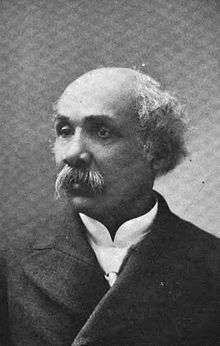William Hannibal Thomas
| William Hannibal Thomas | |
|---|---|
 | |
| Born |
May 4, 1843 Pickaway County, Ohio |
| Died |
November 15, 1935 Columbus, Ohio |
| Education |
Otterbein University Western Theological Seminary |
| Occupation | Teacher, journalist, judge, writer, legislator |
William Hannibal Thomas (4 May 1843 – 15 November 1935) was an American teacher, journalist, judge, writer and legislator.
Biography
Early life
William Hannibal Thomas was born in Pickaway County, Ohio. In 1859, he was the first black student admitted to Otterbein University. He served with distinction in the 5th United States Colored Infantry Regiment during the Civil War of 1861-1865, suffering a gunshot wound that led to the amputation of his right arm.[1] After the war, he attended Western Theological Seminary in Pennsylvania.
Career
He worked briefly at Wilberforce University in Ohio. He then served as a member of the South Carolina Legislature during the Reconstruction period.
In 1878, President Rutherford B. Hayes appointed Thomas U.S. consul to Portuguese Southwest Africa (now Angola).[2] Later he founded his own journal, The Negro.
He is now most remembered for The American Negro (1901),[3] a bombastic work brought out by the Macmillan publishing company. In this book, he maintained that not skin color but the black population's traits of character and behavior were the cause of prejudice. "The negro," he wrote, was "an intrinsically inferior type of humanity."[4] He declared that the black individual in America was slowly and steadily deteriorating, and was "immersed in poverty, steeped in ignorance, stifled with immorality, inherently lazy, and a born pilferer."[5] Several black intellectuals such as Booker T. Washington,[6] W.E.B. Du Bois[7] and Charles W. Chesnutt,[8][9] attacked the author and sought to suppress his book.[10] Washington even used spies to gather damaging information about Thomas.[11]
Death
He died in Columbus, Ohio in 1935.
Bibliography
- Land and Education (1890).
- The American Negro (1901).[12]
See also
Notes
- ↑ Smith, John David (2004). "William Hannibal Thomas, b. 1843," Documenting the American South.
- ↑ Smith, John David (2003). "Thomas, William Hannibal." In: Historical Dictionary of the Gilded Age. Armonk, N.Y.: M.E. Sharpe, p. 492.
- ↑ Smith, John David (2000). Black Judas: William Hannibal Thomas and “The American Negro”. Athens: University of Georgia Press.
- ↑ The American Negro. New York: The Macmillan Company, 1901, p. 238.
- ↑ The American Negro (1901), p. 384.
- ↑ Washington, Booker T. (1901). "The American Negro," The Outlook, Vol. 67, pp. 733–736.
- ↑ DuBois, W.E.B. (1901). "The Sorm and Stress in the Black World," The Dial, Vol. 30, pp. 262–264.
- ↑ Chesnutt, Charles W. (1901). "A Difamer of his Race," The Critic, Vol. 38, pp. 350–351.
- ↑ Thomas, William Hannibal (1901). "Mr. William Hannibal Thomas Defends his Book," The Critic, Vol. 38, pp. 548–550.
- ↑ Smith (2000), p. 212.
- ↑ Harlan, Louis R. & Raymond Smock, eds. (1977). The Booker T. Washington Papers: 1901–2. University of Illinois Press, p. xxvi.
- ↑ "More About the American Negro," The Book Buyer, Vol. 22, 1901, pp. 143–144.
Further reading
- Bracey, Earnest N. (2005). "Analysis of a Racial Parasite: Black Judas: William Hannibal Thomas and the American Negro." In: Places in Political Time: Voices from the Black Diaspora. University Press of America, pp. 40–49.
- Councill, W.H. (1902). "The American Negro: An Answer," Publications of the Southern History Association, Vol. 6, pp. 40–44.
- Luker, Ralph E. (1998). "Theologies of Race Relations." In: The Social Gospel in Black and White: American Racial Reform, 1885-1912. University of North Carolina Press, pp. 268–311.
- McElrath, Joseph, ed. (1997). To Be an Author: Letters of Charles Chesnutt, 1889-1905. Princeton, NJ: Princeton University Press.
- Smith, John David (2003). "The Lawyer vs. the Race Traitor: Charles W. Chesnutt, William Hannibal Thomas, and The American Negro," Journal of The Historical Society, Vol. 3, No. 2, pp. 225–248.
External links
- Works by or about William Hannibal Thomas at Internet Archive
- Works by William Hannibal Thomas, at Hathi Trust
- Portrait at the New York Public Library
- Thomas, William Hannibal (1843-1935)